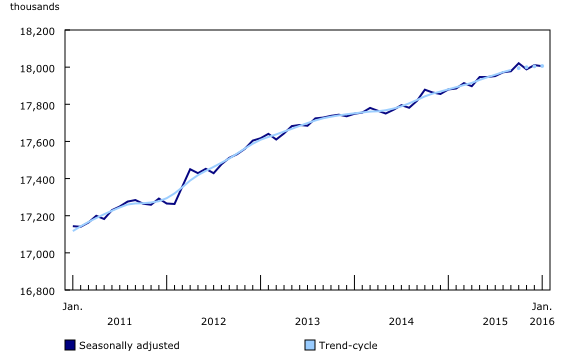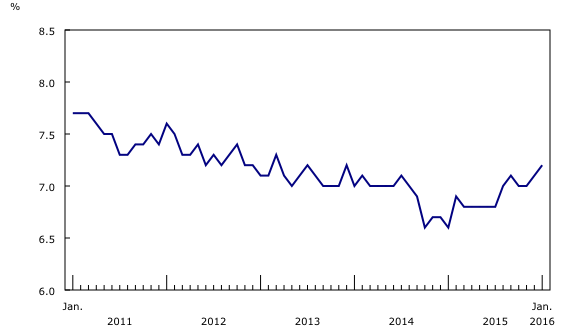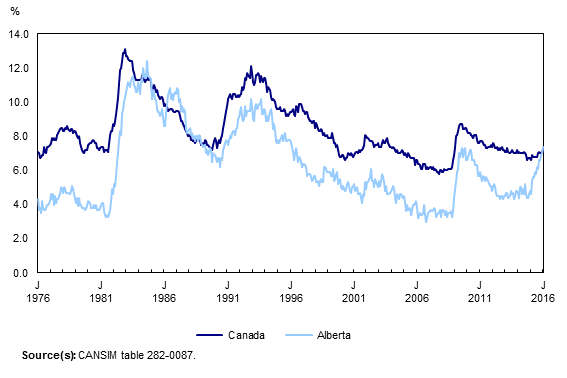Labour Force Survey, January 2016
Archived Content
Information identified as archived is provided for reference, research or recordkeeping purposes. It is not subject to the Government of Canada Web Standards and has not been altered or updated since it was archived. Please "contact us" to request a format other than those available.
Released: 2016-02-05
Employment was virtually unchanged in January (-5,700 or 0.0%) and the unemployment rate edged up to 7.2%.
In the 12 months to January, employment increased by 0.7% (+126,000). Over the same period, the unemployment rate rose from 6.6% to 7.2%, as the labour force grew at a faster pace than employment.
There was little change in both full-time and part-time employment in January. However, compared with 12 months earlier, full-time work increased by 172,000 (+1.2%) while part time was little changed. Over the same period, the number of hours worked rose by 1.2%.
In January, there were fewer employed people aged 55 and older. At the same time, employment increased among women aged 25 to 54.
There were fewer people working in Alberta, Manitoba as well as Newfoundland and Labrador in January. On the other hand, Ontario was the lone province with an employment increase.
Employment declined in agriculture; manufacturing; transportation and warehousing; and public administration. However, there were more people working in information, culture and recreation as well as in the 'other services' industry.
In January, there was little employment change among public and private sector employees and in the number of self-employed workers.
Fewer people aged 55 and older employed
There were 24,000 fewer people aged 55 and older working in January, the first decline since November 2008, and their unemployment rate rose 0.3 percentage points to 6.1%. Despite the monthly decline, employment for this age group grew by 4.8% (+170,000) in the 12 months to January. Over the same period, the population of people aged 55 and over increased by 3.1% (+310,000).
In January, employment rose by 23,000 among women aged 25 to 54. Their unemployment rate was little changed at 5.6% as there was an increase in their labour market participation.
For men aged 25 to 54, employment was little changed on both a month-to-month and a year-over-year basis. However, their unemployment rate increased 1.0 percentage point to 6.7% in the 12 months to January, as more of them searched for work.
For youths aged 15 to 24, employment was virtually unchanged and their unemployment rate remained at 13.0%. However, in the 12 months to January, youth employment fell by 48,000, while their population declined by 44,000.
Employment down in Alberta, up in Ontario
Employment in Alberta decreased by 10,000 in January. This brought year-over-year declines to 35,000 (-1.5%), as losses in full-time work (-73,000) were partly offset by gains in part time (+38,000). The employment decrease in January raised the unemployment rate in the province to 7.4%, the highest since February 1996. The unemployment rate in Alberta was higher than the national rate for the first time since December 1988.
In Manitoba, employment decreased by 5,300 in January, the second decline in three months. With these recent losses, employment in the province was down 1.0% (-6,600) compared with January 2015. At 6.1% in January, the unemployment rate was little changed as fewer people participated in the labour market.
Employment in Newfoundland and Labrador fell by 2,400 in January, continuing a recent downward trend that began in the autumn of 2015. In the 12 months to January, employment losses in the province totalled 7,400 (-3.1%). The unemployment rate was unchanged at 14.4% in January as fewer people participated in the labour market.
For a second month in a row, Ontario was the lone province with employment growth, up 20,000 in January. However, the unemployment rate was unchanged at 6.7% as more people participated in the labour market. In the 12 months to January, employment in the province increased by 100,000 (+1.5%).
In Quebec, employment was little changed for the sixth consecutive month in January, and was up slightly on a year-over-year basis (+31,000). The number of people looking for work edged down in January, lowering the unemployment rate by 0.3 percentage points to 7.6%.
Industry perspective
Employment in agriculture fell for a second consecutive month, down 14,000 in January, following a notable increase in November 2015. On a year-over-year basis, losses totalled 19,000 (-6.2%).
There were 11,000 fewer people working in manufacturing in January, the result of a large decline in Alberta. At the national level, employment in manufacturing was little changed over the 12 months to January.
Employment in transportation and warehousing declined by 10,000 in January but was little changed from 12 months earlier.
In January, employment decreased by 7,200 in public administration, mostly in provincial public administration. On a year-over-year basis, there was little change in employment in public administration.
Employment in information, culture and recreation rose by 16,000 in January, but was little changed compared with January 2015.
In January, there were 9,600 more people employed in 'other services,' such as personal and laundry services as well as repair and maintenance. On a year-over-year basis, employment in this industry was virtually unchanged.
Despite little employment change in natural resources for the month, declines in the industry totalled 13,000 (-3.6%) in the 12 months to January, driven by losses in Alberta.
Employment was little changed in January among public and private sector employees, as well as for self-employed workers.
Compared with January 2015, the number of public sector employees increased by 59,000 (+1.7%), driven by gains in health care and social assistance. Over the same period, there was little change in the number of private sector employees and self-employed workers.
Annual revision
A standard revision has been applied to Labour Force Survey (LFS) estimates, as announced in The Daily on January 26 and 27.
Seasonally adjusted estimates from the LFS were revised back to January 2013 using the latest seasonal factors.
Occupation data estimates have been reclassified to the 2011 National Occupational Classification from the 2006 National Occupational Classification for Statistics.
New CANSIM tables have been created for all occupation-related series and are available from the start of each respective series. A list of the occupation tables is available.
At the same time, the North American Industry Classification System (NAICS) 2012 replaced the NAICS 2007. This change did not affect the CANSIM tables for the LFS as there were only minor changes at the four-digit level.
Note to readers
The LFS estimates for January are for the week of January 10 to 16.
The LFS estimates are based on a sample and are therefore subject to sampling variability. As a result, monthly estimates will show more variability than trends observed over longer time periods. For more information, see "Interpreting Monthly Changes in Employment from the Labour Force Survey." Estimates for smaller geographic areas or industries also have more variability. For an explanation of sampling variability of estimates and how to use standard errors to assess this variability, consult the "Data quality" section of the publication Labour Force Information (71-001-X).
This analysis focuses on differences between estimates that are statistically significant at the 68% confidence level.
The employment rate is the number of employed persons as a percentage of the population 15 years of age and older. The rate for a particular group (for example, youths aged 15 to 24) is the number employed in that group as a percentage of the population for that group.
The unemployment rate is the number of unemployed as a percentage of the labour force (employed and unemployed).
The participation rate is the number of employed and unemployed as a percentage of the population.
For more detailed information, see the Guide to the Labour Force Survey (71-543-G).
Seasonal adjustment
Unless otherwise stated, this release presents seasonally adjusted estimates, which facilitates comparisons by removing the effects of seasonal variations. For information on seasonal adjustment, see Seasonally adjusted data – Frequently asked questions.
Chart 1 shows trend-cycle data on employment. These data represent a smoothed version of the seasonally adjusted time series, which provides information on longer-term movements, including changes in direction underlying the series. These data are available in CANSIM table 282-0087 for the Canada-level employment series. For more information, see the StatCan Blog and Trend-cycle estimates – Frequently asked questions.
Next release
The next release of the LFS will be on March 11.
Products
A more detailed summary, Labour Force Information (71-001-X), is now available for the week ending January 16. From the Browse by key resource module of our website under Publications, choose All subjects then Labour.
Summary tables are now available online. From the Browse by subject module of our website, choose Labour.
Contact information
For more information, contact us (toll-free 1-800-263-1136; 514-283-8300; STATCAN.infostats-infostats.STATCAN@canada.ca).
To enquire about the concepts, methods or data quality of this release, contact Andrew Fields (613-951-3551; andrew.fields@canada.ca) or Emmanuelle Bourbeau (613-951-3007; emmanuelle.bourbeau@canada.ca), Labour Statistics Division.
- Date modified:





